srImathE satagOpAya nama:
srImathE rAmAnujAya nama:
srImadh varavaramunayE nama:
srI vAnAchala mahAmunayE nama:
emperumAnAr explains to vangi puratthu nambi the obstacles that are faced by srIvaishNavas in various aspects of day-to-day life. vangi puratthu nambi
documents these instructions in a wonderful grantham with commentary
named virOdhi parihArangaL (removal of obstacles). We are now viewing
the English translation of this grantham with the help of the
explanations given by srI U. vE. V V Ramanujam swamy. The whole series
can be viewed at https://granthams.koyil.org/virodhi-pariharangal-english/.
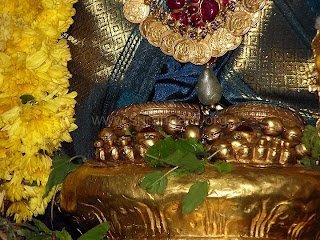
17. upAya virOdhi (உபாய விரோதி) – obstacles in upAyam (means/process)
The following are explained as obstacles with respect to understanding upAyam properly.
- It is already emphasised that one must have firm faith in “bhagavAn who is siddhOpAyam is the top-most upAyam to attain mOksham”. So, a siddhOpAya nishtan (prapannan) should not consider anything other than bhagavAn himself such as karma yOgam, etc as upAyam. Considering such processes as upAyam in itself is an obstacle.
- Considering karma yOgam, etc., at par with siddhOpAyam is a great obstacle. (Translator’s note: We have already seen in previous articles that these other upAyams are achEthanam (insentient) and bhagavAn is supremely sentient – so there is no question of equating them – bhagavAn as upAyam is most glorious).
- This acceptance of “bhagavAn as upAyam” is also an outcome of the grace of emperumAn. Considering that it is triggered by us is an obstacle.
- Generally, our acceptance of “emperumAn as the upAyam” is explained in one way as “sarva mukthi prasanga parihArththam” (ஸர்வ முக்தி ப்ரஸங்க பரிஹார்த்தம்) – this means thinking that “if bhagavAn simply gives mOksham without expecting the acceptance, then everyone should have been given mOksham. So he chooses to give mOksham to the one who accepts him as upAyam”. This is explained by pUrvAchAryas in their vyAkyAnams and rahasya granthams. nammAzhwAr highlights this principle in thiruvAimozhi 4.10.6 as “ellIrum vIdu peRRAl ulagillai” (எல்லீரும் வீடு பெற்றால் உலகில்லை – if everyone in samsAram gets mOksham then there is no purpose for sAsthram) where nampiLLai explains that the importance of sAsthram is upheld by bhagavAn not benedicting mOksham to everyone. piLLai lOkAchAryar also highlights the same principle as in mumukshuppadi. But highlighting only that (to avoid sarva mukthi prasangam he blesses mOksham for the ones who accept him as upAyam) as the reason is an obstacle. (Translator’s note: bhagavAn is sarvasvathanthran (completely independent), he cannot be tied down by any exclusive reasoning – so we cannot think that only to avoid sarva mukthi prasangam he is benedicting mOksham for the ones who accepted him as upAyam).
- emperumAn is the one who is protecting both chith (sentient) and achith (insentient) irrespective of them having the ability to accept emperumAn as upAyam or not. This acceptance of “bhagavAn as upAyam” simply differentiates jIvAthmA from achith. jIvAthmA is sentient – one who has knowledge/intellect. achith is insentient – does not have any intellect (so cannot accept bhagavAn as upAyam). So it is natural for the jIvAthmA with the intellect to accept bhagavAn as upAyam. Considering this natural distinguishing behaviour as an upAyam is an obstacle. (Translator’s note: One should not think, “my acceptance” is the upAyam – bhagavAn is the upAyam, our acceptance is just natural outcome of intellect).
- jIvAthmAs are also fully at the disposal of emperumAn just like achith is. One cannot think that jIvAthmA can independently accept or reject emperumAn (Translator’s note: if emperumAn wants he can easily force any AthmA – he just does not do that).
Thus, the above are explained as obstacles with respect to understanding upAyam properly.
18. upEya virOdhi (உபேய விரோதி) – Obstacles in upEyam (goal)
upEyam means that
which is accomplished by pursuing the upAyam. The following are
explained as obstacles with respect to understanding upAyam properly.
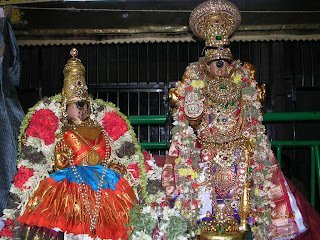
- bhagavathupAyan – prapannan who considers bhagavAn only as the upAyam. He must aim to accomplish kainkaryam to bhagavAn only as the goal. Asking for material benefits, etc from emperumAn is explained as “Asking for loin cloth from a kalpa tharu” and is very inappropriate. Looking for other benefits from emperumAn is an obstacle.
- Reaching bhagavAn through other upAyams such as karma, gyAna, bhakthi yOgams is an obstacle (Translator’s note: for the jIvAthmA who is sub-servient it is natural to accept bhagavAn as upAyam. To pursue self-efforts is against the nature of the jIvAthmA).
- While performing bhagavath kainkaryam one cannot think “I am doing this kainkaryam on my own”. bhagavAn says in bhagavath gIthai 3.27 “ahankAra vimUdAthmA karththA aham ithi manyathE” (அஹங்கார விமூடாத்மா கர்த்தா அஹம் இதி மந்யதே) – confused by ahankAram (ego), the jIvAthmA foolishly thinks he is doing the act on his own. Such ahankAram is an obstacle.
- Considering oneself as akarthA (non-doer), one should not show dis-interest in kainkaryam. (Translator’s note: As explained in srIvachana bhUshaNa dhivya sAsthram, kainkaryams should be performed under the guidance of sAsthram and AchAryan, with great desire and dedication).
- Considering the pleasure derived from kainkaryam to bhagavAn/AchAryan as ones own. As nammAzhwAr explains in thiruvAimozhi 2.9.4 “thanakkEyAga enaik koLLumIthE” (தனக்கேயாக எனைக் கொள்ளுமீதே) – the pleasure should be purely for bhagavAn only. “bhOkthA” means one who enjoys the fruits of an action. bhagavAn is the real bhOkthA. So, there is no room for jIvAthmA to independently enjoy. jIvAthmA having such desire for independent enjoyment is an obstacle.
- bhOgyam means that which is enjoyed. jIvAthmA should completely place himself at the disposal of bhagavAn for bhagavAn’s full pleasure. When bhagavAn becomes pleased and shows such pleasure in his face, jIvAthmA should respond by reciprocating such pleasure. kulasEkara AzhwAr explains this in perumAL thirumozhi 4.9 “padiyAyk kidanthu un pavaLavAy kANbEnE” (படியாய்க் கிடந்து உன் பவளவாய் காண்பேனே) – I will be a foot step at the entrance of your sannidhi (like achith which has no intellect) and reciprocate the pleasure (as chith which has intellect) when I see the joyful smile in your lips. (Translator’s note: This is the highest principle of our sath sampradhAyam called “achithvath pArathanthriyam” – being like achith at the full disposal of bhagavAn yet reciprocating pleasure like jIvAthmA when bhagavAn reveals his joy). This principle (of eradicating self-centered pleasure) is explained in “nama:” in the second part of dhvaya mahA manthram. ALavndhAr explains the same principle in his sthOthra rathnam 46 “kadhA … praharshayishyAmi” (கதா … ப்ரஹர்ஷயிஷ்யாமி) – longing to bring pleasure for emperumAn. When jIvAthmA reciprocates bhagavAn‘s pleasure, bhagavAn becomes fully pleased. His pleasure is the sole objective of our kainkaryam. Considering any other way is an obstacle.
19. upEyathri virOdhi (உபேயத்ரி விரோதி) – More obstacles in upEyam (goal)
Some more obstacles are identified here in continuation of the previous point. upEyam is the result which is accomplished by upAyam. For a srIvaishNava prapanna, emperumAn is both upAyam (means) and upEyam (goal). emperumAn being upEyam means reaching emperumAn in paramapadham, experiencing great bliss in his most auspicious qualities, developing full loving attachment towards him and finally performing kainkaryam (loving service) to him. This is called “bhagavath anubhava janitha prIthi kAritha kainkaryam” (பகவத் அநுபவ ஜநித ப்ரீதி காரித கைங்கர்யம்). This is the ultimate goal. Let us now see the obstacles for this result.
-
- Desiring for a specific goal (other than the previously explained kainkaryam). This attitude is not appropriate for a srIvaishNava and is an obstacle.
- Desiring for dhrusta palam (worldly benefits – what can be seen and enjoyed in this life) such as good wealth, food, clothes, house, wife, children, fame, etc. When compared to the eternal bliss that is acquired by serving emperumAn, these results are very insignificant. So, having such attachment is an obstacle.
- Desiring for adhrushta palam (benefits in higher worlds – what cannot be seen and enjoyed in this life). This can be classified in to two aspects:
- Desiring for pleasures in heavenly worlds (the abodes of brahmA, rudhran, indhran, etc). This is an obstacle.
- Desiring for serving emperumAn in paramapadham (the highest abode) where there is unlimited bliss. Not desiring for such state is an obstacle – i.e., one should desire and aspire for eternal kainkaryam.
- Stopping at bhagavath kainkaryam is an obstacle. thadhIyArAdhanam (worshipping thadhIya – devotees of bhagavAn) which is called bhAgavatha kainkaryam is greater than bhagavathArAdhanam (kainkaryam to bhagavAn). thadhIyArAdhanam does not just mean feeding devotees with prasAdham – it means much more than that such as serving them and giving them proper care.
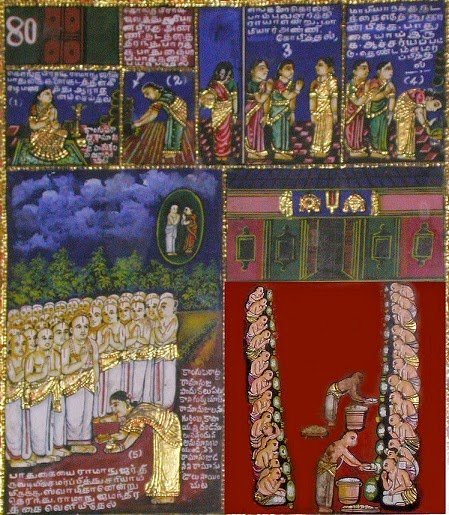
kongu pirAtti beatifully performing bhAgavatha kainkaryam during emperumAnAr‘s yAthrA
- Considering bhAgavatha kainkaryam as something inferior (to bhagavath kainkaryam) is a big obstacle.
- Being satisfied with some (a little bit) AchArya kainkaryam is an obstacle. AchArya is the foremost of bhAgavathas. One can never be fully satisfied – there should be constant desire to perform more and more kainkaryam for AchAryan. Just like a hungry person will eat whatever is served on his plate and will be eager to eat whatever is being cooked, a sishya should desire for all possible kainkaryams for his AchArya. Considering “I have done enough for my AchAryan” is an obstacle.
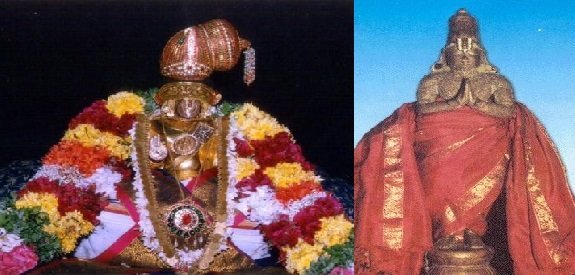
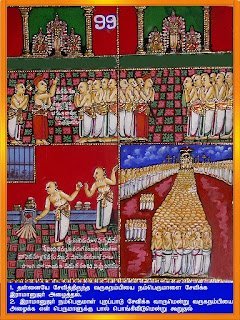
We will continue with the next section in the next article.adiyen sarathy ramanuja dasan
archived in https://granthams.koyil.org, also visit https://granthams.koyil.org, https://acharyas.koyil.org, https://sriperumbuthur.blogspot.com
In telugu – https://granthams.koyil.org/2019/03/26/virodhi-pariharangal-3-telugu/
In kannada – https://granthams.koyil.org/2022/01/30/virodhi-pariharangal-3/